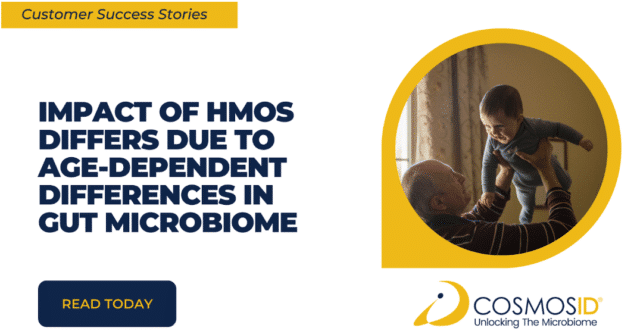Prebiotics are non-digestible food ingredients that selectively promote the growth and activity of beneficial gut microbiota, thus conferring health benefits to the host. Human milk oligosaccharides (HMOs) are prebiotics that are present in human milk and selectively stimulate the growth of bifidobacteria in infants.
A new study has investigated the effects of HMOs in 6-year-old children and adults, compared to inulin and fructooligosaccharides (FOS), two commonly used prebiotics.
In this article, we’ll discuss the background, findings and outcomes of this research, as well as how the CosmosID-HUB enabled researchers throughout the study.
Background
The study, which was published in the journal Nutrients, evaluated the effects of HMOs and blends of HMOs [2’Fucosyllactose (2’FL), Lacto-N-neotetraose (LNnT), 3’Sialyllactose (3’SL), 6’Sialyllactose (6’SL)] on the gut microbiota of six children and six adults, using ex vivo SIFR® technology.
The SIFR® technology bioreactors harboring supplements and conditions simulating the anaerobic gut conditions were inoculated with fecal material from subjects. The DNA extraction and sequencing of fecal inoculums post-incubation allowed evaluation of microbiome composition variation due to different HMOs.
Analysis of microbiome compositions from the reads of samples was performed on the CosmosID-Hub.
Findings
HMOs and their blends maintained higher α-diversity as compared to the combination of inulin and fructooligosaccharide (FOS/IN). FOS/IN was bifidogenic exclusively in adults, enhancing Bifidobacterium adolescentis, which is abundant in the adult gut and considered a healthy gut taxa.
The HMO blend of 3′SL/6′SL was exclusively bifidogenic in children, and promoted growth of Bifidobacterium pseudocatenulatum, which is adundant in children. The HMO combination of 2′FL/LNnT was bifidogenic for both age groups.
All treatments significantly increased acetate, propionate, and butyrate (in adults only) with age- and product-dependent differences.
Among the HMOs, 6′SL specifically stimulated propionate, while LNnT stimulated butyrate. Indole-3-lactic acid, 3-phenyllactic acid, and gamma-aminobutyric acid, which are linked to immune health and the gut-brain axis, were most affected by 2′FL and HMO blends in both children and adults. This correlated with specific Bifidobacteriaceae. Finally, 2′FL/LNnT increased melatonin in children, while 3′SL increased folic acid in adults.
Outcomes
The study highlights that age-dependent differences in gut microbiota composition can impact prebiotic outcomes, emphasizing the importance of development of age-specific nutritional supplements.
HMOs were shown to be promising modulators in both the adult and children’s microbiota. The observed HMO-specific effects, likely originating from their structural heterogeneity, suggest that blends of different HMOs could maximize treatment effects.
Overall, the study supports the notion that prebiotics have potential as therapeutic agents for various conditions related to gut dysbiosis.
Further studies are needed to explore the mechanisms underlying the age- and product-specific effects of prebiotics on the gut microbiota and the metabolites they produce, to develop personalized dietary interventions for different age groups.
How did CosmosID support this research?
The CosmosID-HUB enabled researchers to easily analyze microbiome compositions from the reads of samples and quickly supercharge their research.
The CosmosID-HUB is a powerful, cloud-based genomics platform that provides access to proprietary bioinformatics libraries, enabling deep microbiome analysis. In addition, it offers intuitive visualization tools and bacterial strain-tracking capabilities, making it an ideal platform for rapid and easy analysis of microbiome samples.
With the CosmosID-HUB, researchers were able to quickly analyze microbiome compositions across age groups and identify prebiotics-specific effects on gut microbiota, metabolites produced, and metabolic pathways stimulated. This enabled them to draw meaningful conclusions about how age-dependent changes in microbiome composition impact prebiotic outcomes.
If you’d like to learn more about how CosmosID can be used to support research and clinical applications, don’t hesitate to get in touch today.
Unlock the power of the microbiome. Get started with the CosmosID-HUB now.
Want more like this? Sign-up to our newsletter to get the latest news from CosmosID:


